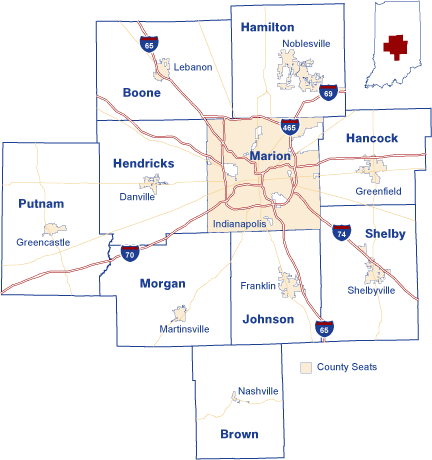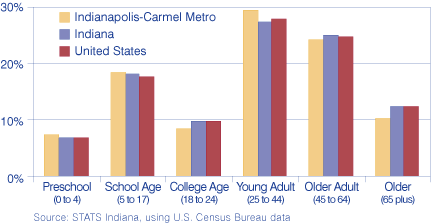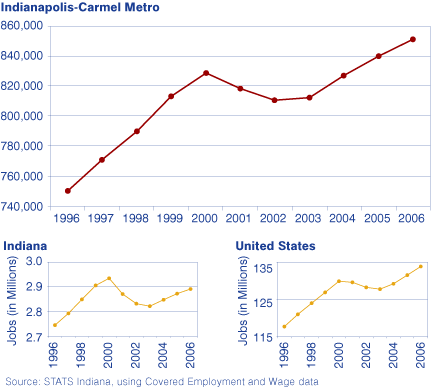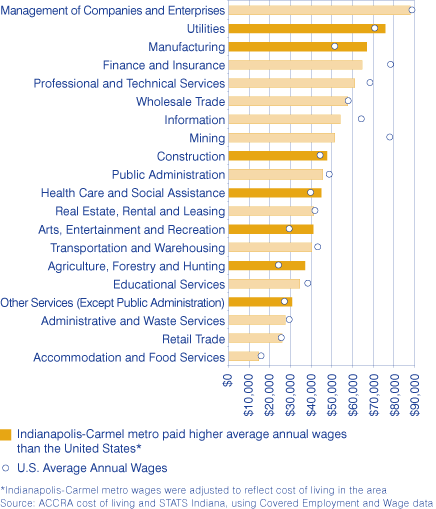Leading Indiana's Growth: The Indianapolis-Carmel Metro Story Told by STATS Indiana
This article, the fifth in the series, will focus on Indiana's largest metro, the Indianapolis-Carmel metro. All data used for this article are available using the USA Counties and Metros Side-by-Side profiles on STATS Indiana (www.stats.indiana.edu) unless otherwise noted.

The Area
The Indianapolis-Carmel metro includes the following 10 counties: Boone, Brown, Hamilton, Hancock, Hendricks, Johnson, Marion, Morgan, Putnam and Shelby. More than one in every four people in Indiana lived in the Indianapolis-Carmel metro in 2007, which is equivalent to 0.6 percent of the nation's population. From 2000 to 2007, the Indianapolis-Carmel metro grew at a faster pace (11.1 percent growth) than Indiana (4.4 percent growth) and the United States (7.2 percent growth). The same was true in the 10-year span between 1990 and 2000 and the 20 years between 1980 and 2000.
What's driving this population gain? In the last year, the Indianapolis-Carmel metro saw net domestic migration of nearly 8,600 and net international migration of more than 2,700 people. To compound these figures, the Indianapolis-Carmel metro saw a natural increase (births minus deaths) of 13,267. How does this compare to the state? Indiana lost 505 residents as a result of net domestic migration but gained more than 9,000 people from other countries and also experienced a natural increase of 33,408 people.
How does the high number of births affect the overall composition of Indianapolis-Carmel age groups? Compared to Indiana and the United States, the Indianapolis-Carmel metro has a higher percentage of preschool-age and school-age students, as well as a higher percentage of young adults age 25 to 44 (see Figure 1). It makes sense that there are higher proportions in the latter age group given the high proportion of children, since the young-adults category encompasses the majority of women likely to have a child under the age of 18.
Figure 1: Age Distribution as a Percent of Total Population, 2006

Jobs & Wages
From 1996 to 2006, the Indianapolis-Carmel metro has added jobs at a fairly steady pace. Other than the drop from 2000 to 2002 (during the recession), jobs in the metro have been climbing (see Figure 2). Including the losses in the beginning of the decade, the Indianapolis-Carmel metro has increased jobs by 13.5 percent in the last 10 years. This growth rate is barely shy of the nation's 13.6 percent growth rate over that same time. Meanwhile, the state overall experienced less than half that growth (5.3 percent). The Indianapolis-Carmel metro rebounded from the recession a little faster than the state overall. In fact, the metro exceeded its 2000 peak in jobs in 2005, but jobs statewide have yet to reach the level they were at in 2000.
Figure 2: Jobs in the Indianapolis-Carmel Metro, Indiana and the United States, 1996 to 2006

Three industries in the Indianapolis-Carmel metro made up one-third of total covered employment in 2006: manufacturing (11.8 percent of total covered jobs), retail trade (11 percent), and health care and social assistance (10.4 percent). Figure 3 shows how these proportions compare to the state and nation.
Figure 3: Jobs as a Percent of Total Covered Employment, 2006

Total covered jobs in the Indianapolis-Carmel metro averaged $43,601 when adjusted for cost of living, just above the national average of $42,535. Among the highest paying industries in the Indianapolis-Carmel metro were management of companies and enterprises, utilities, and manufacturing (see Figure 4). There were seven industries that paid higher wages in the Indianapolis-Carmel metro than at the national level, and all but two industries paid higher than the state (mining and educational services).
Figure 4: Average Annual Wages by Industry in the Indianapolis-Carmel Metro, 2006

The only industry that didn't average more than $20,000 per year in the Indianapolis-Carmel metro, Indiana or the United States was accommodation and food services, which can be expected given that many of these workers are part-time employees.
Overall, Indianapolis-Carmel wages stack up well against U.S. wages, staying between 97 percent and 102 percent of U.S. wages since 1996.
Conclusion
The Indianapolis-Carmel metro is growing. Population increased faster than the nation and two-and-a-half times faster than the state. Jobs increased at a comparable pace to the nation and, once again, two-and-a-half times faster than the state. Wages have been rising fairly steadily while remaining similar to national wages, and better than state wages in almost every industry. In other words, Indiana's capital and surrounding counties are leading the state.
Molly Manns, Associate Editor
Indiana Business Research Center, Kelley School of Business, Indiana University
